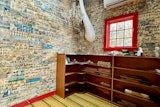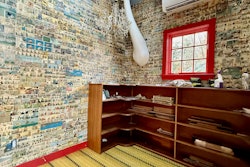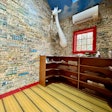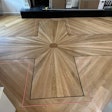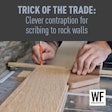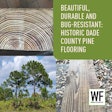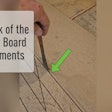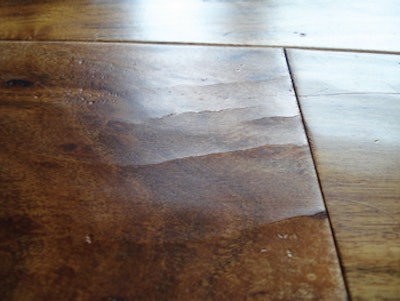
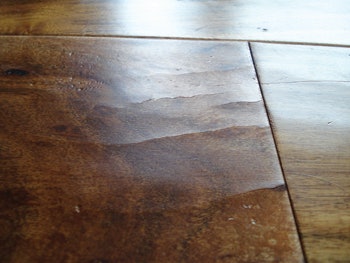 A wear layer held in place as it shrunk in low-humidity conditions led to face-checking on this wood flooring.
A wear layer held in place as it shrunk in low-humidity conditions led to face-checking on this wood flooring.
Engineered flooring has come a long way since it was first introduced to the market nearly 70 years ago. As these products continue to gain popularity, a multitude of style and construction options are available. Largely seen as a more versatile alternative to solid wood floors, engineered products can be installed over a variety of surfaces in many applications, expanding the reach of where wood flooring can be used.
Yet while engineered flooring typically is more dimensionally stable than solid, it is not infallible. The wood wear layer still expands and contracts with humidity and moisture content fluctuations. Overestimating the ability of engineered products to handle extremes can cause big headaches if the floor fails. To help ensure a successful installation, specifiers, salespeople, retailers and installers should all know the answers to these common questions before recommending engineered flooring for a client.
1. Do I need to acclimate the flooring?
Solid wood flooring requires that you acclimate the flooring to the environment in which it's going to be used. With engineered flooring, however, you need to condition the space to meet the guidelines of the manufacturer. Typically, manufacturers require a range between 35 and 55% relative humidity (RH), but not all guidelines are the same. Some manufacturers may have a range of 40 to 60% RH, while others may require 30 to 50% RH. Retailers and distributors with a large inventory of different products must understand the RH range of each one. Before the actual sale is the right time to confirm that the end-user has the ability to control the climate within those ranges. The installer should also know these ranges of the flooring and make sure the conditions fall within the recommended RH range and that climate control is in place to maintain those conditions after installation.
RELATED: Engineered 101: Understand the Fundamentals of Engineered Wood Flooring
Just because the product is engineered doesn't mean that installers should skip taking moisture readings on the flooring or subfloor, either. The RH range and equivalent moisture content (MC) applies to the conditions where the flooring is stored, as well as installed. If there's a fluctuation at the storage site or excess moisture on the subfloor, problems can occur with the floor later. Knowing the recommended RH range and keeping the flooring within that range for the life of the product ensures the best performance of the product.
Whether you should unpackage the flooring at the job site and "acclimate" it in the traditional sense of the word depends on the manufacturer. Many engineered products are intentionally boxed in a manner intended to reduce airflow and moisture transfer; manufacturers of these products will tell you not to acclimate the product at the job site, as it may distort or affect the product in some other way prior to installation.
2. Can I use it where I live?
Not necessarily. As with the question above, you need to know the acceptable RH range from the manufacturer of the flooring you are installing. If you live in Las Vegas, for example, where the average RH hovers around 30%, and the flooring manufacturer's low range is 40%, it becomes more difficult to maintain acceptable living conditions, especially without strict humidity control. In parts of the country such as the Midwest, where there are vast humidity swings between winter and summer, the same problem also exists. When the furnace is constantly running in a house in Minnesota because it's 10 degrees Fahrenheit outside, it's difficult to maintain the RH at 40%. Such imbalances can potentially lead to problems such as face-checking/splitting, delamination and end-gapping. And because the flooring was maintained in an environment outside of the manufacturer's acceptable range, the failures won't be covered under warranty. Again, it comes down to knowing your product and knowing the RH levels for all times of the year where the product will be installed.
3. Can I install it in more areas than solid products?
 After a big relative humidity change, lathe marks in this rotary-peeled floor became apparent on the surface.
After a big relative humidity change, lathe marks in this rotary-peeled floor became apparent on the surface.
As a general rule, engineered flooring is more dimensionally stable than solid wood flooring, allowing for more installation options. The plywood core under the wear layer is less susceptible to expansion and contraction than solid wood flooring, which makes it possible to install it on a variety of surfaces and choose from several installation methods and systems. For example, you might have better success installing a floating click-system product over radiant heat than solid planks, or you might be able to glue down an engineered wood floor in a basement where you wouldn't dream of installing a solid product. Whatever the conditions, you still need to consider the installation method, whether it's gluing, stapling, clicking or floating, and follow the manufacturer's guidelines for certain conditions.
While engineered flooring can be installed in places that may not be ideal for solid products, it still is not meant for extreme conditions. Large humidity swings, excess moisture and lack of climate control will cause an engineered floor to fail just like any other wood floor. Generally, engineered floors tend to move lengthwise as well as in width when they expand or contract, and end-joint gapping is a common problem that occurs with moisture imbalances.
RELATED: How Many Wood Floor 'Failures' Start Before the Sale
Before any flooring is sold or specified, it's crucial to know the conditions of the environment and whether the manufacturer's RH range can be met and maintained. The most important job of the salesperson is qualifying the product for the conditions. Humidity can vary from floor to floor or even room to room. In large condominium developments, for example, the RH could be much lower in the penthouse than on the ninth floor, because humidity always falls to the lowest point. Even with proper climate control, fluctuations can occur. Once the floor is sold, the installer should confirm the site conditions meet required specifications, because if the floor fails, oftentimes the installer becomes the one responsible.
 This engineered floor shrank after being exposed to low-humidity conditions, causing it to shrink on all sides and exposing the lighter color of the unstained board edges. Some face-checking is also evident.
This engineered floor shrank after being exposed to low-humidity conditions, causing it to shrink on all sides and exposing the lighter color of the unstained board edges. Some face-checking is also evident.
4. Will different wear layer cuts, finishes and species perform differently?
With so many surface options, it's important to know where the flooring is going and how different cuts, finishes and species will react to variances on either end of the moisture spectrum. Engineered flooring faces are cut from the logs using one of three techniques: rotary peeling, slicing or sawing. (See the "Making the Cut" sidebar below.) Rotary peeled tends to be the least expensive method because it's done in mass production, produces the least amount of waste and can be manufactured for about a third of the cost. The logs are peeled similar to a roll of paper towels, and as the wood bends, tiny lathe checks are formed on the underside of the wear layer. When the wear layer is glued to the plywood substrate, the adhesive fills in the voids, and the checks are unnoticeable. However, when the environment pushes the RH threshold and the floor expands or contracts, the lathe checks may become more pronounced as they transfer to the surface. Sliced and sawn wear layers aren't as susceptible to surface checking, but they also are more expensive.
Finishes, species and widths are also a factor to take into consideration. Smooth, hard-surface finishes tend to show imperfections and face-checking more than an oil finish on a rustic-grade floor. Closed-grain species such as beech, maple and some tropical species tend to show more imperfections than open-grain species. So, if the floor is going in a high-rise in a drier climate like Denver, where you can expect the floor to experience more shrinkage, a tropical species with a hard finish may not be the best option. Also, in areas that experience drastic RH fluctuations, an engineered 5-inch maple plank floor might be more prone to problems like face-splitting-the wide planks experience a lot of seasonal movement but the wear layer is restricted in place because it is glued to the core below it, so it may split. In low-RH conditions, the floor may also experience a phenomenon that has come to be known as "dry-cupping," in which the face of the flooring shrinks, taking on a cupped appearance.
 The wear layer is delaminating from this flooring after being installed in a job site with low relatively humidity conditions.
The wear layer is delaminating from this flooring after being installed in a job site with low relatively humidity conditions.
5. Is a Thicker Wear Layer Always Better?
A common sales pitch for engineered flooring is, "The thicker the wear layer, the better the flooring." Depending on the conditions and the core below, that may or may not always be the case. The appeal is that a thicker wear layer allows for sanding and refinishing more often, although today many floors are recoated without needing to be completely resanded. Of course, if the customer wants a different stain color or if the finish is damaged badly enough, resanding is still required. What may be more important is what the wear layer means for dimensional stability and the ability of the product to withstand varied living conditions. A thicker wear layer may have a tendency to react to moisture like a solid product, with greater expansion and contraction than a thinner wear layer.
Something that can present a challenge about engineered flooring is that the core and the wear layer react differently to moisture-the two could have different MC levels and become out of balance. How the floor performs in these conditions depends on many factors, including MC when it was manufactured, core construction types and thickness of the wear layer.
Given these parameters, engineered flooring still provides customers and installers with many options for a great-looking, long-lasting installation. Whatever flooring is chosen, it's important to know the conditions where the flooring will be installed and the acceptable RH range from the manufacturer. The more you know about each flooring product and the site conditions where it's going, the more likely you are to avoid callbacks and have happy customers.
Sources for this article included: Don Conner, NWFA; Rick Jones, Swiff-Train Co.; Bob Goldstein, Pro Wood Floor Supply Inc.; and Roy Reichow, National Wood Floor Consultants Inc.
Making the CutEngineered flooring is manufactured by cutting the logs in one of the following three ways. Each cut affects the appearance and the performance of the face. Rotary Peeled: The logs are first soaked in hot water until the wood fibers are soft. Then they are placed on a lathe and the wood is peeled off the log similar to unrolling paper towels. Peeling is the fastest method with the least amount of waste, which makes it the least expensive cut. This process also tends to give the wood a more plywood appearance as the patterns in the logs are repeated with each cut. Rotary peeled flooring is also more susceptible to showing lathe marks produced by the wood bending as it rolls off the log and to face-checking when the wear layer cups. Sliced Face: The logs are soaked and treated using the same method as rotary peeled, but they are then sliced using a large scissor-style blade similar to a meat cutter at a deli. This method gives sliced-face wear layers less of a plywood appearance. They won't show lathe marks like rotary-peeled floors and are less likely to face-check. However, this manufacturing process tends to make them more costly. Sawn Face: Similar to solid wood flooring, sawn-face logs are kiln-dried and sawn off the log using various types of saws and cuts. This gives sawn-face engineered flooring the same look and feel of a solid product. However, the sawing process yields a high amount of waste, making this cut the most expensive of the three. |
Checking Examined
The article about checking in solid wood floors that appeared in the October/November 2011 issue generated the most comments online—both positive and critical—of any article posted yet to date at this website. A few things to emphasize:
|
More Warranty NotesIn addition to keeping an engineered floor in the correct parameters for the living conditions, there are some other factors that are important to note regarding engineered flooring warranties:
|










